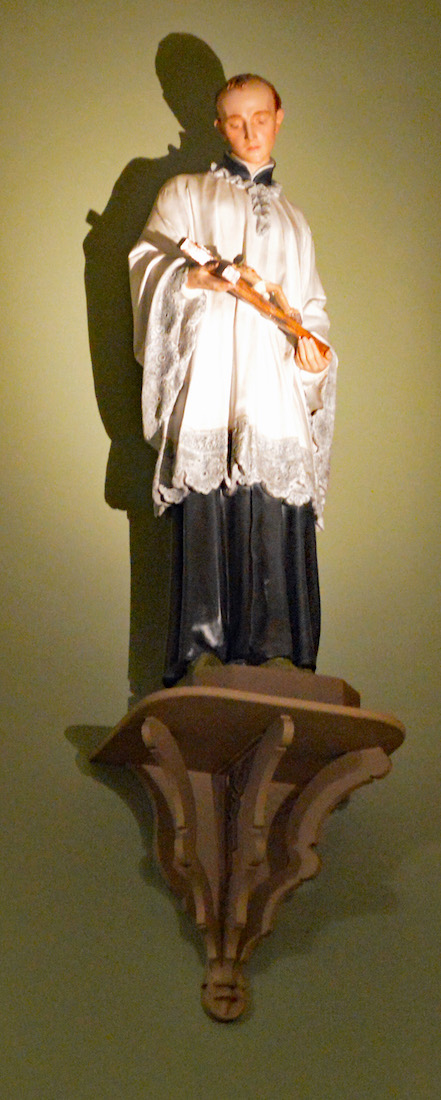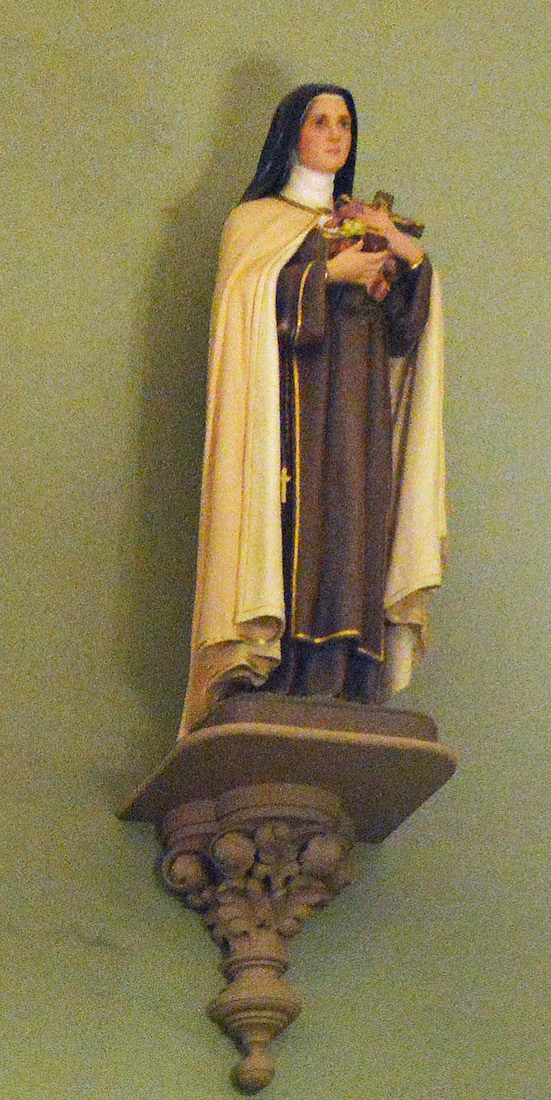WALL SAINTS
[I have been unable to identify some of these saints. I would be delighted to receive any helpful information!]
1. UNKNOWN SAINT (SOUTH WALL)
2. ST THÉRÈSE (NORTH WALL)
Thérèse of Lisieux OCD, born Marie Françoise-Thérèse Martin, also known as Saint Therese of the Child Jesus and the Holy Face, was a French Catholic Discalced Carmelite nun who is widely venerated in modern times.
3. ARCHANGEL ST MICHAEL (NORTH WALL)
Michael is an archangel in Judaism, Christianity, Islam and the Baha'i faith. The earliest surviving mentions of his name are in 3rd- and 2nd-century BC Jewish works, often but not always apocalyptic, where he is the chief of the angels and archangels and he is the guardian prince of Israel and is responsible for the care of Israel.] Christianity adopted nearly all the Jewish traditions concerning him, and he is mentioned explicitly in Revelation 12:7–12, where he does battle with Satan, and in the Epistle of Jude, where the author denounces heretics by contrasting them with Michael.
4. UNKNOWN SAINT (NORTH WALL)
5. ST JOAN OF ARC (NORTH WALL)
Joan of Arc ( c. 1412 – 1431) is a patron saint of France, honoured as a defender of the French nation for her role in the siege of Orléans and her insistence on the coronation of Charles VII of France during the Hundred Years' War. Claiming to be acting under divine guidance, she became a military leader who transcended gender roles and gained recognition as a saviour of France.
6. ST JOHN VIANNEY (NORTH WALL)
The statue of John Vianney is on the North wall above the West balcony. John Vianney (1786 – 1859) was a French Catholic priest who is venerated in the Catholic Church as a saint and as the patron saint of parish priests. He is often referred to as the ‘Curé d'Ars’ (i.e. the parish priest of Ars), internationally known for his priestly and pastoral work in his parish in Ars, France, because of the radical spiritual transformation of the community and its surroundings. Catholics attribute this to his saintly life, mortification, persevering ministry in the sacrament of confession, and ardent devotion to the Blessed Virgin Mary.
7. ST ANTHONY (SOUTH WALL)
This statue of St Anthony holding the Christ Child is on the South wall, and above the West balcony. Anthony of Padua, OFM (1195 – 1231) was a Portuguese Catholic priest and friar of the Franciscan Order. He was born and raised by a wealthy family in Lisbon, Portugal, and died in Padua, Italy. Noted by his contemporaries for his powerful preaching, expert knowledge of scripture, and undying love and devotion to the poor and the sick, he was one of the most quickly canonized saints in church history, being canonized less than a year after his death. He was proclaimed a Doctor of the Church by Pope Pius XII on 16 January 1946. The image of St Anthony holding the Christ Child comes from an often told story of the young Jesus appearing tro the aged saint in his cell.
8. UNKNOWN SAINT (SOUTH WALL)
9. ST VINCENT DE PAUL (SOUTH WALL)
Vincent de Paul, CM (1581 – 1660), commonly known as Saint Vincent de Paul, was a French Catholic priest who dedicated himself to serving the poor. He was renowned for his compassion, humility, and generosity. Vincent was canonized in 1737 and is venerated as a saint in both the Catholic Church and the Anglican Communion.
10. ST FRANCIS XAVIER (SOUTH WALL)
Francis Xavier, SJ (1506 – 1552), venerated as Saint Francis Xavier, was a Navarrese Catholic missionary and saint who was a co-founder of the Society of Jesus. Francis Xavier became widely noteworthy for his missionary work, both as an organiser and as a pioneer; he reputedly converted more people than anyone else had done since Paul the Apostle.
11. ST FRANCIS OF ASSISI (SOUTH WALL)
Giovanni di Pietro di Bernardone, OFM, better known as Francis of Assisi (c. 1181 – 1226) was an Italian mystic and Catholic friar who founded the Franciscans. He was inspired to lead a life of poverty as an itinerant preacher. One of the most venerated figures in Christianity, Francis was canonized by Pope Gregory IX on 16 July 1228. He is usually depicted in a robe with a rope as a belt. He is often pictured with a skull – a sign of mortality.
12. ST ANNE WITH YOUNG MARY (NORTH WALL)
According to Christian apocryphal and Islamic tradition, Saint Anne was the mother of Mary and the maternal grandmother of Jesus. Mary’s mother is not named in the canonical gospels. In writing, Anne’s name and that of her husband Joachim come only from New Testament apocrypha, of which the Gospel of James (written perhaps around 150) seems to be the earliest that mentions them.












